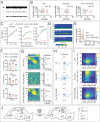GABAergic Progenitor Cell Graft Rescues Cognitive Deficits in Fragile X Syndrome Mice
- PMID: 39823534
- PMCID: PMC11904963
- DOI: 10.1002/advs.202411972
GABAergic Progenitor Cell Graft Rescues Cognitive Deficits in Fragile X Syndrome Mice
Abstract
Fragile X syndrome (FXS) is an inherited neurodevelopmental disorder characterized by a range of clinical manifestations with no effective treatment strategy to date. Here, transplantation of GABAergic precursor cells from the medial ganglionic eminence (MGE) is demonstrated to significantly improve cognitive performance in Fmr1 knockout (KO) mice. Within the hippocampus of Fmr1-KO mice, MGE-derived cells from wild-type donor mice survive, migrate, differentiate into functionally mature interneurons, and form inhibitory synaptic connections with host pyramidal neurons. MGE cell transplantation restores Ras-PKB signaling in pyramidal neurons, enhances AMPA receptor trafficking, rescues synaptic plasticity, and corrects abnormal hippocampal neural oscillations. These findings highlight the potential of GABAergic precursor cell transplantation as a promising therapeutic strategy for FXS.
Keywords: brain oscillation; cell therapy; hippocampus; long‐term potentiation; medial ganglionic eminence.
© 2025 The Author(s). Advanced Science published by Wiley‐VCH GmbH.
Conflict of interest statement
The authors declare no conflict of interest.
Figures







References
MeSH terms
Substances
Grants and funding
LinkOut - more resources
Full Text Sources
Medical
Research Materials
Miscellaneous
